A Pair of Skating Owls (first half of 17th century)
The artist is said by the Rijksmuseum to be Adriaen Pietersz van de Venne but the engraver may have been Jacob Matham - previously - according to the intermediary source, Artpx. (some background stains have been removed) [Thanks Ian!]
"Above the couple a banderole announces 'how well we suit each other', in other words, 'each to his own'. The owls are intended to show that people should consort with their own sort: poor with poor, rich with rich, owl with owl."



Known as 'Das Tierbuch des Petrus Candidus' (animal book), this 1460 Vatican Library Manuscript by the Italian humanist, Pier Candido Decembrio, continues the tradition of early natural history books in the manner of Pliny the Elder, the Physiologus and Thomas of Cantimpré which served as Candido's sources.
Commissioned by Ludovico Gonzaga, Marquis of Mantua, 'Das Tierbuch' describes all known real and mythical animals, but the wonderful illustrations were a 16th century addition to the manuscript. One way we know this is because the rhinoceros drawing is an exact copy of Albrecht Dürer's famous 1515 stylised depiction of the animal.
The colourful images above (the top one has been background cleaned and only the third one can be enlarged) come from Austria's University of Salzburg Book of the Month series where other interesting critters can be found. Their illustrations were scanned from a 1984 reprint of 'Das Tierbuch des Petrus Candidus'.

'Das Buch von Kaiser Sigmund' by Eberhard Windeck (The Life and Times of Emperor Sigismund) is expected to fetch between £1 million to £1.5 million when it comes up for auction at Sotheby's in London on July 7. [Lot 26 has a number of images and copious background notes] I'm obliged to the enterprising Wikimedia user, Pölkkyposkisolisti, who managed to extract the large version of the image and upload it in double-quick time. If there was a payroll, I would consider putting them on it.
"This is one of the great vernacular chronicles of the fifteenth century, and a major (and often unique) source for the life of Sigismund of Luxembourg (1368-1437) [..]
Eberhard Windeck (c. 1380- c.1440) was a member of a successful merchant family of Mainz. He first met Sigismund in Prague in 1395. He travelled extensively throughout Europe, both for business and on diplomatic missions, living at various times in Paris, Vienna, Buda, Nuremberg, Venice, and other cities.
His contacts and sources of information are formidable. He entered the service of Sigismund in 1414, and accompanied him to the Council of Constance and elsewhere. The Buch von Kaiser Sigmund is a celebration of the emperor's close involvement in very many major events, including the resolution of the papal schism, the Hussite Wars (there is a fine illustrated account here of the burning of Jan Hus in 1415), and the story of Joan of Arc, including what are reputed to be the earliest known pictures of Joan of Arc, who was martyred in 1431."
"[F]olio 88r, the catching of a vast whale at Dunkirk which yielded 120 tonnes of blubber, with the whale (depicted as an enormous green-backed fish) is hacked at by a man, note as Windeck is present in the picture this may well record that he was an eye-witness to this event."
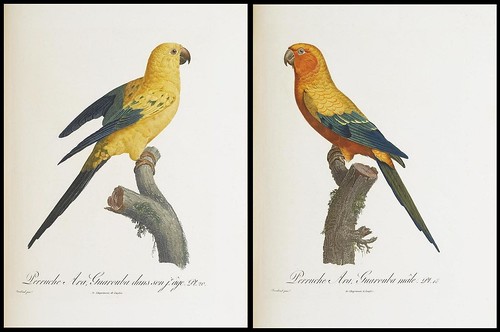
IN: 'Histoire Naturelle des Perroquets' by François Le Vaillant (1801-1805)
The book sold recently at Sotheby's for $195K [Philobiblos lists this and other results from the sale] {the parrot illustrations above have been cropped slightly}
"After he had made himself Emperor, it was part of Napoleon's deliberate policy to initiate a series of magnificent publications that would vie with those undertaken on the orders of Louis XIV. These were sent as presents to crowned heads, men of science, and learned bodies, in evidence of the splendours of the Empire ... The works of Levaillant owe their sumptuous character to ... this impetus. His 'Histoire Naturelle des Perroquets' is, unwittingly, a part of the glories of Napoleonic France"
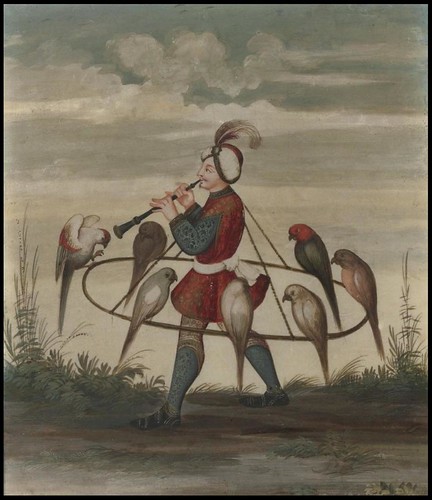
'Le Fauconnier' (The Falconer)
17th century; watercolour/gouache on vellum (spliced from screenshots)
17th century; watercolour/gouache on vellum (spliced from screenshots)
"A charming view of a falconer or falcon seller playing a wind instrument and carrying 7 birds on a hoop suspended from his neck. The figure's turban suggests an Indian or Mughal origin for the wearer.Update: See septentrio's entry with medieval falconry images.
In France, falconry achieved its greatest development in complexity, scale and magnificence in the seventeenth century under Louis XIII. The king owned 300 birds, subdivided into six specialized équipages, for hunting the heron, the kite and the crow, the flight at the river, the flight at the partridge, and so on. Numerous paintings, tapestries and works of literature survive from this period. In the Indian sub-continent, falconry appears to have been known from at least 600 years BC. Falconry became especially popular with the nobility and the Mughals were keen falconers."

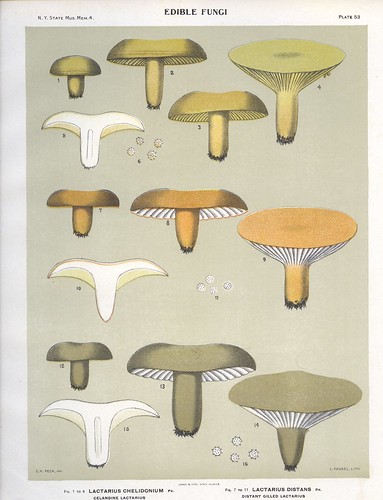
These illustration plates of edible mushrooms by Charles Horton Peck almost certainly come from an 'Annual Report of the State Botanist' (of New York) from the late 19th century. I don't think it's this specific report, but it's from around that time. Thanks to Patrick from The Dead Gekko Society who won the illustrations and scanned them.

This allegorical illustration of biblical scenes tied to the Noah's Ark episode and including a somewhat stylised globe of the known world appears in Romeyn de Hooghe's landmark 1682 publication of the Dutch Lutheran Bible. The image was found among the database of book illustrations at the University of Amsterdam and is spliced together from screencaps. You can get a feel for the spectacular quality of the engraving designs at this ebay site.
"This Bible, the first to include a map, has over 160 hand-colored illustrations by Romeyn de Hooghe, perhaps the most significant Dutch book illustrator of the late seventeenth and early eighteenth centuries."*****On the subject of Dutch engraving, a massive digitisation project of book illustrations and prints is currently underway in Holland which I am reliably informed ought to bear some web-accessible fruit by the end of this year. The collaborative DutchPrintsOnline site aims to have in the order of 2 million(!) web pages online by late 2010.****
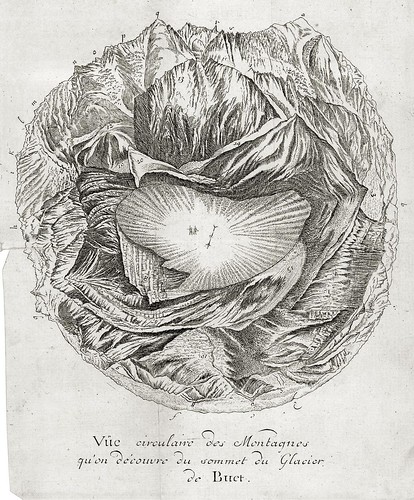
'Vue circulaire des montagnes à
partir du sommet du Glacier de Buet'
[the point marked 'a' at top right is Mont Blanc]
partir du sommet du Glacier de Buet'
[the point marked 'a' at top right is Mont Blanc]
It comes from a 1790 book called 'Itinéraire de la Vallée de Chamonix, d'une Partie du Bas-Vallais et des Montagnes Avoisinantes' by Jacob-Pierre Van Berchem (Berthout). It brings to mind the panorama handbills post from November. The image source is a mostly unexplored (as yet, by me) database from University of Lausanne in Switzerland called Viatimages, featuring a large number of book illustrations relating to the Alps. [via bibliparis4]

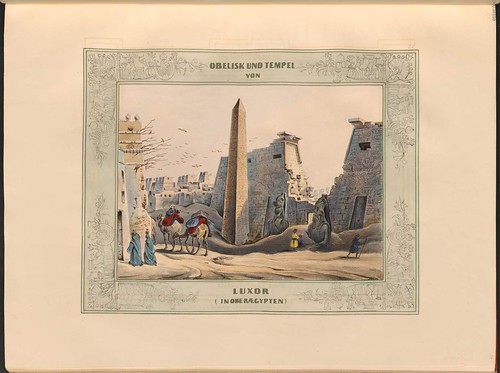

IN: 'Malerische Ansichten aus dem Orient' (Picturesque Views of the Orient)
Heinrich von Mayr's suite of what appear to be hand-coloured lithographs from 1839-1840 displays about sixty scenic views from Egypt (mostly), Syria and Palestine. I thought the borders were a nice design touch. [source]

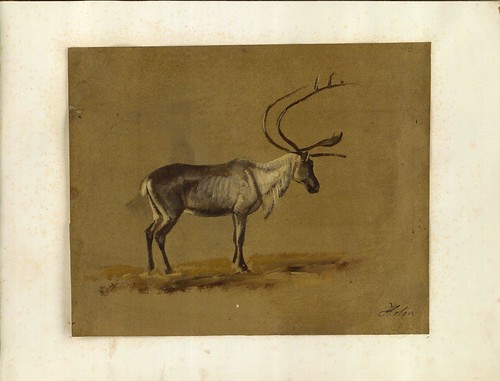

Helene Bournonville had a connection to the Danish arts community through her husband's ballet career. She kept an album (essentially a Friends Book) in which some of the most well known and gifted painters and writers of Copenhagen and beyond (including Hans Christian Andersen) contributed poems, sketches and paintings over a fifty year period (~1840 to 1890).
The Danish government intervened in 2005 to prevent the sale of the album to a foreign investor and funds were raised to keep the album in Denmark. The scans of the varied contents are hosted by the Royal Library of Denmark [click 'Se stambogen her' for the very tolerable flash viewing window and note the thumbnail icon bottom left]
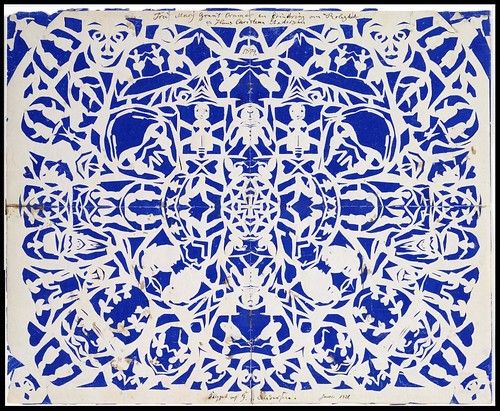
Speaking of Hans Christian Andersen, this papercut of his (spliced together from screencaps) was sold at a Christie's auction in the last day or so for ~$24,000
"Original papercut design, intricately cut and depicting several popular motifs including ballet dancers, windmill men with heart-shaped windows, pierrots, Ole Lukoie or sandmen, flower garlands, palm trees, storks, and gnomes [..and dated] 1870."
Recommended related posts from:

The University of Heidelberg has six months worth of issues from 1872 of the magazine or periodical (in French), 'La Scie'. [choose an issue and then 'Voschau' for thumbnails]
There are lots of satirical cartoons. I haven't really looked into the background at all, although it's fairly obvious that the publication is devoted to or derived from the 1870/1871 Siege of Paris, one way or another.

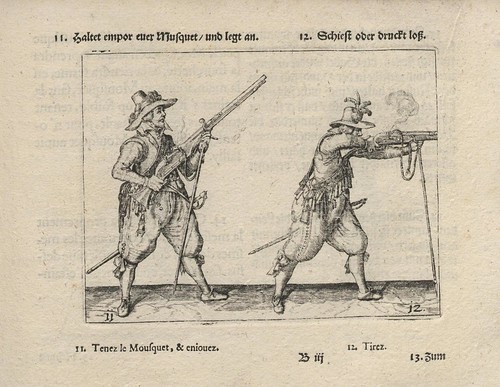
These two images of soldiers practising rifle techniques come from a 1664 drill book, in both French and German, by Jacob de Gheyn, called 'Die Drillkunst..', hosted by the University of Dresden [click on the book icon for thumbnail images]


Frontispiece and a fold-out plate from 'New-erfundenes Grosses Königs-Spiel' (~Great King's Game) by Christoph Weickhmann from 1664, online at Herzog August Bibliothek, Wolfenbüttel. Apparently this is Weickhmann's attempt to modify the traditional chess game with checkers-like characteristics [info].

An undated stone rubbing of ancient Chinese folklore figures found (somehow) in the Soda collection among the Nichibunken Databases at the International Research Center for Japanese Studies.

'Wandering Turtle' © Brodsky and Utkin
Click through on this imaginative architectural fantasy etching to see a small set of illustrations uploaded by Flickr user, Endless Forms Most Beautiful that were scanned from 'Brodsky & Utkin: The Complete Works', 1990.
"Alexander Brodsky and Ilya Utkin are the best known of a loosely organized group of Soviet artists known as "Paper Architects", who designed much but built little in the early days of Glasnost, in the late 1980s. [..] Underlying the wit and visual inventiveness is an unmistakable moral: that the dehumanizing architecture of the sort seen in Russian cities in the 1980s and 1990s, and elsewhere around the globe, takes a sinister toll."This 2006 MetropolisMag article on Brodsky is worth reading, but in my view there aren't any other websites deserving of particular mention. If you are interested, there is quite a bit of visual and written material around, scattered across many sites, that will be turned up from diligent searching. [via].
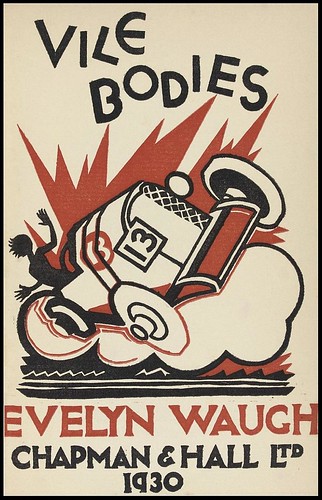
The 1930 first edition cover of Evelyn Waugh's second novel, 'Vile Bodies' [Chapman & Hall] (spliced together from screencaps). The book was recently sold at Christie's for £2,250.
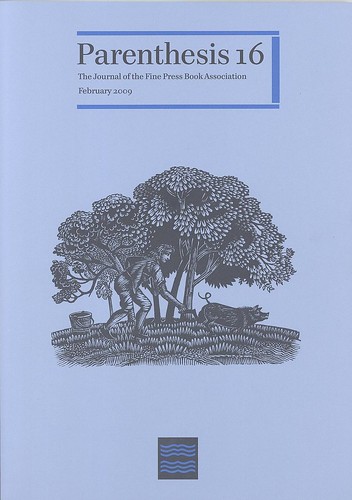
Plug One: 'Parenthesis: The Journal of the Fine Press Book Association'
This is the cover of the most recent edition [CONTENTS], a richly illustrated 64 page catalogue that covers fine and private press printing as well as bookbinding, typography, collecting, publishing and related areas. It's free to members of the association: membership is $48 annually [JOIN]. A selection of past and current articles is available here.
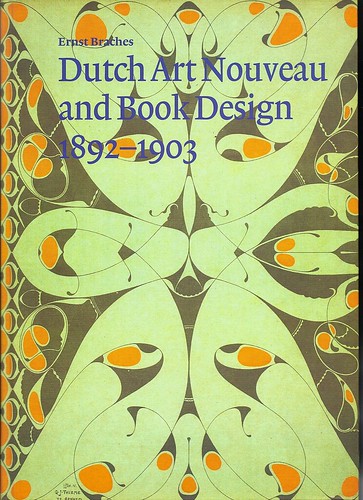
Plug Two: 'Dutch Art Nouveau and Book Design 1892–1903' by Ernst Braches was originally published in 1973. The first translation into English of this authoritative and copiously illustrated work was published in 2009 and is available from De Buitenkant publisher's site. UPDATE: From the wholesaler's site, you can see a very short video of a sampling of page images (click 'look inside' down the bottom)

Plug Three: 'The Alchymical Zoodiac' is a privately published illustrated book by Ilene Winn-Lederer. Subtitled: 'A Celestial Bestiary of Sixteen Curious Illustrations Regarding the Signs & Symbols of Astronomy, Astrology & Alchymy', the book (and preview) is available from the artist/author's website.
Other things...
- Plug Four: Angela from [parenthetically] has co-authored a book: 'The Handy Book of Artistic Printing: Collection of Letterpress Examples with Specimens of Type, Ornament, Corner Fills, Borders, Twisters, Wrinklers, and other Freaks of Fancy'; which has its own related blog. That will lead to the marvellous Sheaff Ephemera Collection {recently reviewed by Design Observer}.
- Jews, Commerce, & Culture, a modest online exhibition site from the University of Pennsylvania Library.
- New York Times review of 'Pages of Gold' - Vivid and Weighty - Orphaned Medieval Leaves' at the Morgan Library and Museum [slideshow]
- Charley from Lines and Colors has created an iPhone app. DinoMixer: kids of all ages can mix and match dinosaur parts.
- Pen and Parchment: Drawing in the Middle Ages exhibition blog at the Met. Museum [overview from Medieval News]
- Directory of Web Resources for the Rare Materials Cataloger at New Mexico State University.
- Colección Blaisten - Mexican art from colonial to contemporary times.
- Dessins Français - drawings by (mostly) lesser known French artists from the 17th to early 20th centuries.
- The Community Archive is a hub for New Zealand’s archival organisations to manage and showcase their collections.
- Summer Reading Lists from Rebecca Blood.
- Feeds / BibliOdyssey / bookmarks / links / twitter / Advertise
- nb. the "Plugs" above are gratis.




















6 comments :
Thanks for posting my Fungi prints. I'm glad I had something of intrest.
Deadgekko
That image of the falconer is very intriguing, curiously practical yet odd-looking
I kept meaning to observe (but was halted by slow internet and numerous distractions) that I have a nice little framed postcard of the owls at home, but it's portrait rather than landscape, so I wonder if it's a different version. Or, of course, just the main part of the image.
The griffin seems quite ungainly and personally uncomfortable with the whole situation.
Beautiful and intriguing, what a treat!
There's another - later / coloured - version of the skating owls illustration here.
Post a Comment
Comments are all moderated so don't waste your time spamming: they will never show up.
If you include ANY links that aren't pertinent to the blog post or discussion they will be deleted and a rash will break out in your underwear.
Also: please play the ball and not the person.
Note: only a member of this blog may post a comment.